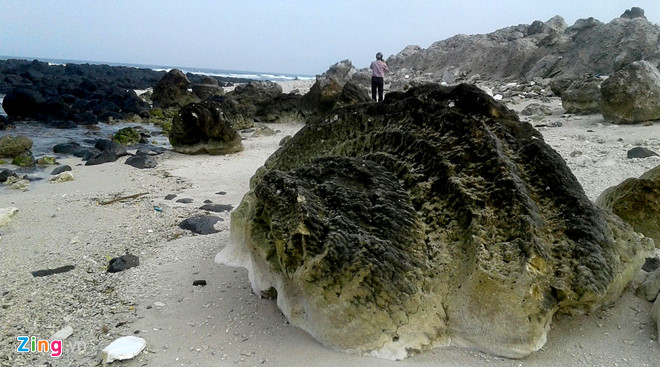Experts from the Việt Nam Institute of Geosciences and Mineral Resources have found a unique complex of fossilised coral – believed to date from 4,000 to 6,000 years ago – on the coast of Lý Sơn Island, 30km off Quảng Ngãi Province mainland.

Dr Nguyễn Xuân Nam from the institute told Việt Nam News that a group of researchers and scientists found the population of palaeontological coral reefs over an area of 20,000sq.m extending 400 metres along the coast, northeast of the island.
The coral reef complex, which was named Cối Xay (a manual rice mill seen in rural areas in the old days) coral, includes a heap of coral blocks scattered on the beach.
“It’s an amazing discovery. We haven’t found such a coral reef complex in Việt Nam before. It’s like manual rice mills dotted along the beach,” Nam said.
“The discovery of this strange coral population helps explain the palaeontological environment during the Flandrian transgression, creating an attraction for tourists, researchers and paleontologists,” he said.
Nam said the discovery was part of initial research to recognise Lý Sơn Island as a global geo-park.
He warned the province should enact special protection for the coral reef complex, as well as the islands, to prevent them being destroyed by human activities and overloaded with tourism and construction.
He said some residents did not know the importance of the reefs, and they even took parts of the coral to use in farming.
Samples of the coral reefs have been sent for examination at international laboratories to establish their age and structure as well as scientific name.
In response to a warning by scientists from the institute, the central province people’s committee released an urgent decision to protect the population of newly found coral reefs, banning all construction and approaches or human activities in the area.
According to archaeologists, Lý Sơn Island is a dormant volcano. The terrain of the island was created from eruptions 25 to 30 million years ago, leaving landscapes with rocks, caves, cliffs, rock arches and a lake.
The island has abundant relics related to the Sa Huỳnh, Champa and Đại Việt (or Great Việt) cultures that existed on the island for thousands of years, according to Dr Phạm Quốc Quân, a member of the National Heritage Council.
Quân said ceramic fragments and other antiquities from archaeological excavations revealed the first community living on the island belonged to the Sa Huỳnh culture between 2,500 and 3,000 years ago,
Geologist Vũ Cao Minh warned that exploitation of beach sand and coral reefs for farming garlic and onions could result in damage to coral reefs around the island, while the boom in hospitality services could lead to a mass collapse of the underground water structure of the island.
Scientists also warned the province about a proposal to develop a hotel and resort complex because it would damage the heritage of the island.
The islands and a vast coastal area of Bình Sơn District are being considered as a site for a Global Geo-Park for approval by UNESCO.
The island, known as the "King of Garlic" in Việt Nam, is a tranquil destination with 21,000 inhabitants, most of whom make their living from farming garlic and spring onions and fishing.
Footnote: The ancient corals bear a resemblance to 3.7 billion year old stromatolytes found living in the seas on the north-west coast of Australia. — VNS